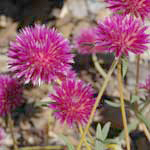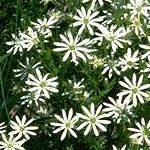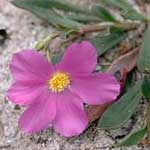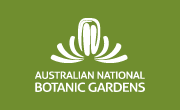Systematics and Evolution (HA)
Caryophyllales
The program is currently undertaking taxonomic studies in three main families of this tribe in Australia: namely Amaranthaceae, Caryophyllaceae and Portulacaceae. This relatively primitive group has been well researched in other parts of the world, but there is still controversy as to the membership of the tribe and relative relationships. Comprehensive phylogenetic analyses are needed to place the Australian genera.
 Amaranthaceae Amaranthaceae
Project Leader: J. Palmer, T. Lally, C.H. Miller:
The family Amaranthaceae has a worldwide distribution in tropical and warm temperate regions, with 71 genera and c. 1000 species. This project is focused on producing a flora treatment of the family for the Flora of Australia. The treatment covers 15 genera with 184 species; 157 of which are endemic or native. The genera Nyssanthes, Omegandra, Hemichroa and Ptilotus (excluding one species) are endemic, Ptilotus being the largest genus with c. 96 species.
For Ptilotus, a draft Flora of Australia treatment was completed by Prof. G. Benl (deceased, formerly at Munich Herbarium, Germany) in the 1990s. Research is currrently focussing on improving the resolution of species groups within the genus.
A revision of the genus Gomphrena has been published with a total of 33 species, including 12 new species. About one third of the known species of Gomphrena occur in Australia, the remainder occur in Central and South America and southern United States. In Australia there are 14 naturalised Amaranthus species and 11 indigenous ones including two new endemics to be published shortly. Many of the native Amaranthus species occur in central and northern Australia whereas the introduced species occur mainly in the east and south of the country. There are several economically important species in the family. For example Amaranthus tricolor and Alternanthera sessilis are vegetables, Amaranthus cruentus is a grain crop, Gomphrena globosa and Amaranthus caudatus are common garden ornamentals and Alternanthera philoxeroides and Aerva javanica are widespread weeds.
 Caryophyllaceae Caryophyllaceae
Project Leader: J. West, L.G. Adams, C.H. Miller, K.J. Cowley:
This is a cosmopolitan but mainly northern hemisphere family of some 80 genera and more than 2000 species. In Australia the family is represented by 24 genera and c. 110 species, many of which are introduced to this country, e.g. Cerastium (mouse-ear, chickweed), Silene (campion, catchfly). We are undertaking both floristic studies and more in-depth research concentrating on the native taxa. Flora treatments have been contributed for both regional projects (e.g. Flora of Victoria) or on a national basis (Flora of Australia). For the four primarily native genera, Spergularia, Stellaria, Scleranthus and Colobanthus, research focuses on revisionary, phylogenetic and biogeographic studies of the Australian elements.
 Portulacaceae Portulacaceae
Project Leader: J G West:
My main research in this family focuses on revisionary, phylogenetic and biogeographic studies of the Australian elements, primarily Calandrinia and Portulaca. The short term aim of my work is to resolve the relationships among the Australian species, and in the longer term to understand the phylogenetic relationships of these genera within the family. The succulent ephemeral endemic Calandrinia species show considerable diversity in arid and semi-arid regions. The genus provides some worthy examples of the evolution of different life history strategies in closely related species, with inbreeding and outcrossing mechanisms being well developed and reflected in the morphology. Portulaca is a pantropical genus, which has not previously been treated taxonomically or phylogenetically on a world-wide basis. Several regional treatments have been produced for non-Australian taxa over the past 10 years, resulting in an uncoordinated number of accounts and particularly with the cosmopolitan P. oleracea being divided into numerous infraspecific taxa. The genus is largely tropical in Australia with several species also occurring in Malesia.
|
![An Australian Government Initiative [logo]](/images/austgovt_canbr_90px.gif)

![An Australian Government Initiative [logo]](/images/austgovt_canbr_90px.gif)



